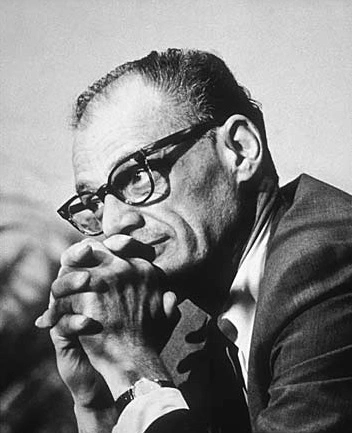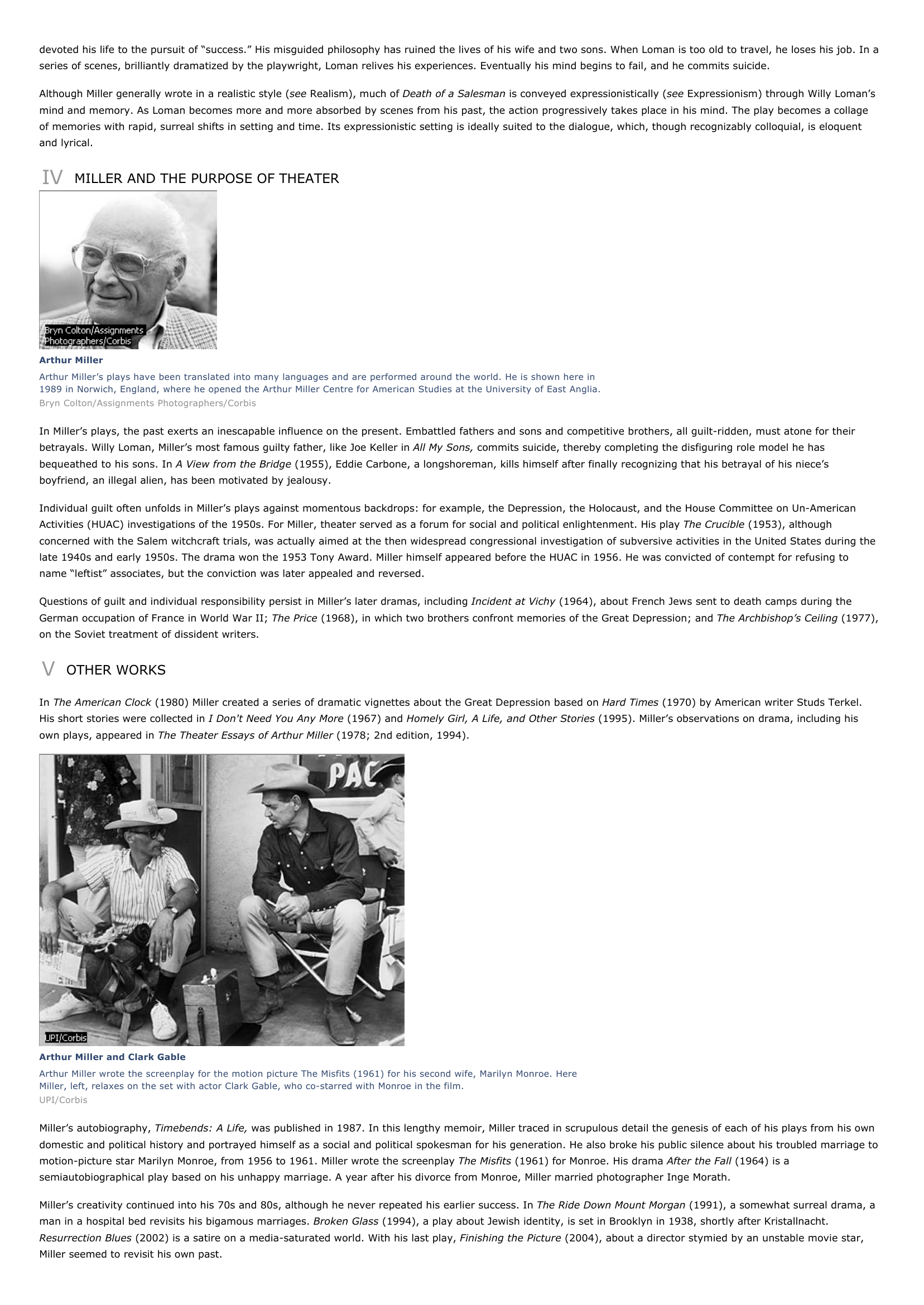Arthur Miller I INTRODUCTION Arthur Miller American playwright Arthur Miller began writing plays while a student at the University of Michigan.
Publié le 12/05/2013

Extrait du document


«
devoted his life to the pursuit of “success.” His misguided philosophy has ruined the lives of his wife and two sons.
When Loman is too old to travel, he loses his job.
In aseries of scenes, brilliantly dramatized by the playwright, Loman relives his experiences.
Eventually his mind begins to fail, and he commits suicide.
Although Miller generally wrote in a realistic style ( see Realism), much of Death of a Salesman is conveyed expressionistically ( see Expressionism) through Willy Loman’s mind and memory.
As Loman becomes more and more absorbed by scenes from his past, the action progressively takes place in his mind.
The play becomes a collageof memories with rapid, surreal shifts in setting and time.
Its expressionistic setting is ideally suited to the dialogue, which, though recognizably colloquial, is eloquentand lyrical.
IV MILLER AND THE PURPOSE OF THEATER
Arthur MillerArthur Miller’s plays have been translated into many languages and are performed around the world.
He is shown here in1989 in Norwich, England, where he opened the Arthur Miller Centre for American Studies at the University of East Anglia.Bryn Colton/Assignments Photographers/Corbis
In Miller’s plays, the past exerts an inescapable influence on the present.
Embattled fathers and sons and competitive brothers, all guilt-ridden, must atone for theirbetrayals.
Willy Loman, Miller’s most famous guilty father, like Joe Keller in All My Sons, commits suicide, thereby completing the disfiguring role model he has bequeathed to his sons.
In A View from the Bridge (1955), Eddie Carbone, a longshoreman, kills himself after finally recognizing that his betrayal of his niece’s boyfriend, an illegal alien, has been motivated by jealousy.
Individual guilt often unfolds in Miller’s plays against momentous backdrops: for example, the Depression, the Holocaust, and the House Committee on Un-AmericanActivities (HUAC) investigations of the 1950s.
For Miller, theater served as a forum for social and political enlightenment.
His play The Crucible (1953), although concerned with the Salem witchcraft trials, was actually aimed at the then widespread congressional investigation of subversive activities in the United States during thelate 1940s and early 1950s.
The drama won the 1953 Tony Award.
Miller himself appeared before the HUAC in 1956.
He was convicted of contempt for refusing toname “leftist” associates, but the conviction was later appealed and reversed.
Questions of guilt and individual responsibility persist in Miller’s later dramas, including Incident at Vichy (1964), about French Jews sent to death camps during the German occupation of France in World War II; The Price (1968), in which two brothers confront memories of the Great Depression; and The Archbishop’s Ceiling (1977), on the Soviet treatment of dissident writers.
V OTHER WORKS
In The American Clock (1980) Miller created a series of dramatic vignettes about the Great Depression based on Hard Times (1970) by American writer Studs Terkel. His short stories were collected in I Don't Need You Any More (1967) and Homely Girl, A Life, and Other Stories (1995).
Miller’s observations on drama, including his own plays, appeared in The Theater Essays of Arthur Miller (1978; 2nd edition, 1994).
Arthur Miller and Clark GableArthur Miller wrote the screenplay for the motion picture The Misfits (1961) for his second wife, Marilyn Monroe.
HereMiller, left, relaxes on the set with actor Clark Gable, who co-starred with Monroe in the film.UPI/Corbis
Miller’s autobiography, Timebends: A Life, was published in 1987.
In this lengthy memoir, Miller traced in scrupulous detail the genesis of each of his plays from his own domestic and political history and portrayed himself as a social and political spokesman for his generation.
He also broke his public silence about his troubled marriage tomotion-picture star Marilyn Monroe, from 1956 to 1961.
Miller wrote the screenplay The Misfits (1961) for Monroe.
His drama After the Fall (1964) is a semiautobiographical play based on his unhappy marriage.
A year after his divorce from Monroe, Miller married photographer Inge Morath.
Miller’s creativity continued into his 70s and 80s, although he never repeated his earlier success.
In The Ride Down Mount Morgan (1991), a somewhat surreal drama, a man in a hospital bed revisits his bigamous marriages.
Broken Glass (1994), a play about Jewish identity, is set in Brooklyn in 1938, shortly after Kristallnacht. Resurrection Blues (2002) is a satire on a media-saturated world.
With his last play, Finishing the Picture (2004), about a director stymied by an unstable movie star, Miller seemed to revisit his own past..
»
↓↓↓ APERÇU DU DOCUMENT ↓↓↓
Liens utiles
- Rhythm-and-Blues Music I INTRODUCTION Tina Turner American singer Tina Turner began performing rhythm-and-blues music in a band led by her former husband, Ike Turner, in the 1960s.
- Essay English : In Arthur Miller’s play “All my sons”, Joe Keller is a hero in his family and in the neighborhood even if he did some very awful things.
- Musical I INTRODUCTION George Gershwin American pianist, songwriter, and composer George Gershwin was one of the most important figures in popular song in the 1920s and 1930s.
- Film Noir I INTRODUCTION Lynch's Blue Velvet The motion picture Blue Velvet (1986) brought wide acclaim to American director David Lynch.
- William Shakespeare I INTRODUCTION William Shakespeare English playwright and poet William Shakespeare, who lived in the late 1500s and early 1600s, is regarded as the greatest dramatist in the history of English literature.









